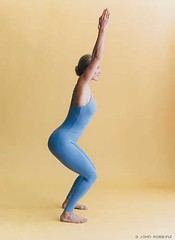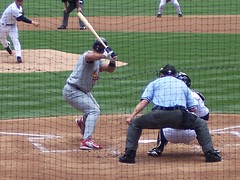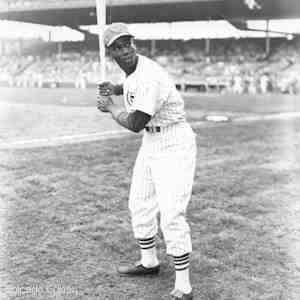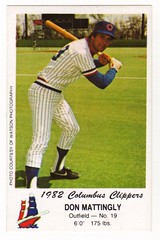Saturday, April 21, 2007
Crouching tiger
Baseball cognoscenti have been theorizing for nearly 20 years about the reasons for surges in home run hitting. Here's one they've missed.
In 1987, before steroids were on the radar screen, there was a major spike in the home run production. Back then, the theory was advanced that MLB was using a more tightly wound, "rabbit" baseball, one that would travel faster and farther when struck by the bat.
The next home run surge -- the one that gave us Mark McGwire, Sammy Sosa and Barry Bonds, and that lingers to this day -- began in 1995, the season after the worst baseball strike in history cancelled the World Series.
At first, the "rabbit ball" theory returned, along with a theory that umpires were instructed to reduce the strike zone, pursuant to an MLB conspiracy to increase run-scoring in order to recapture the fans lost due to the players strike. Though steroid use had not really gotten on the radar screen in a big way, baseball mavens talked about the increased strength and bat speed of hitters, resulting primarily from weightlifting and physical bulking up, combined with lighter, thinner-handled bats with thicker barrels that could be whipped faster through the hitting zone.
And of course, it was argued that hitting norms themselves had changed: more emphasis on hitting home runs, and more financial reward for doing so. Thus, fewer and fewer hitters try to master the skills of hitting for high average, of bunting, of moving runners ahead with skillfully placed ground balls. And hitters now all grip bats at the end of the handle rather than choking up (more whip action and thus bat speed), because they're trying to hit home runs rather than poke the ball through or over the infield.
The pitching side of things was also mined for theories. Commenters noted a new unwillingness of pitchers to throw "brushback" or even "inside" pitches.* The reluctance resulted from a new tendency of hitters to charge the mound if they believed the pitcher was throwing at them, combined with tougher rules against intentionally throwing at hitters. By not brushing back or throwing inside, it was argued, the hitter would feel more comfortable "digging in" (whatever that means) and could more easily reach pitches on the "outside" half of the strike zone.
Finally, in the late 1990s to a couple of years ago, the dominant theory of increased home run hitting has been steroids. Really, though, steroids are an explanation for the way many hitters may have "bulked up" their bodies, increasing their strength and bat speed.
There's probably something to all these theories, yet something important is missing. This idea came to me last night when, after the Mets' deflating 7-3 loss to the Braves, I cheered myself up by watching a DVD showing highlights from the Mets' 1969 World Series victory.
The 1969 season was undoubtedly still characterized by a dominance of pitching over hitting. In 1968, earned run averages as well as batting averages hit all time lows. (Carl Yastrzemski led the AL in batting with a .301 average.) The game seemed sufficiently out of balance to MLB authorities that a decision was made to "lower" the pitching mound... that is to set an official limit to the permissible height of pitching mounds at a figure lower than what most ballparks tended to build.
Offense increased a bit in 1969 as a result, but pitching stats remained somewhat eye-popping. The AL pennant-winning Baltimore Orioles had a starting rotation whose 1-4 pitchers won 23, 20, 16 and 14 games respectively. Mets ace Tom Seaver went 25-7 with a 2.28 ERA, and the Mets number 4 starter had an ERA of 3.01.
It's not surprising, then, that the 1969 Series featured dominant pitching. The scores were 4-1, Baltimore; followed by 4 consecutive Mets wins of 2-1, 5-0, 2-1 and 5-3. Except for a handful of home runs, hits were almost all scratch singles -- seeing eye grounders through the infield, bloops in to the shallow outfield. The outfielders seemed to play shallow, yet never seemed to have to back up to catch a fly ball.
The relative lack of power hitting was visually remarkable, but what was particularly striking was how virtually every hitter batted more or less from a crouch. Not necessarily the extreme, practically-doubled over stance of Pete Rose or Wade Boggs. But nobody -- not even the power hitters -- stood up straight. To a man, the batters took their stance by bending over at the waist and rounding their shoulders.
When you watch hitters today, you don't see that. Hitters' upper bodies are canted forward, yes, but not because they're crouching. Rather, it's a natural, upright posture resulting from bending at the knees.
Modern batting stances are "yogic," something like chair pose in that respect. And although the commentators don't discuss it, this body positioning is a major part of an approach to hitting that generates more power. Hitter's today increase their bat speed with body torque. The hips begin aligned at approximately right angles to the path of the ball, then swivel toward the ball. The upper torso and shoulders swivel slightly behind, followed by the swiveling of the arms. This segmented torquing creates a mechanical advantage, with each segment -- hips, torso, arms moving with greater force and speed since they travel a greater distance through the same arc, like the difference between the handle and the end of a whip. All this generates a lot of power. If you don't believe me, look at Albert Pujols, today's most feared hitter. His stance has the most pronounced knee bend combined with upright torso. But all hitters do some version of this now.
Bending at the waist and crouching disrupts this torquing. If I really knew this stuff I could explain why, but with the upper body curving toward the ground at shoulders and waist, any swiveling will be in the wrong direction -- not forward, but downward. In fact, no one could hit that way, and in order to make contact with the ball, crouched hitters, would have to come out of their crouch. They would lose valuable time, achieve less torque, rely more on arm motion with less torso motion, and generate less power. If you watch footage of hitters from the 1970s and earlier, you see a lot more looping arm swings, more independence between arm and torso, as though they were taking two-handed tennis racket strokes. In contrast to today's hitters, whose hips are almost always square to the pitch when their bat connects, these crouched hitters are more likely not to have come fully around at the moment of contact.
Given the great emphasis that sports knowledge places on kinesiology -- "body mechanics" to baseball people -- it's an astonishing oversight that commentators haven't offered this explanation for the modern "power surge" in hitting.
Why did it take so long for baseball to discover the upright batting stance? The more-or-less crouched batting stance had been taught to hitters for decades. The theory behind it was (1) you create a smaller body profile and thus a smaller, more difficult "strike zone" for the pitcher to target; (2) this is how we've always taught it. Baseball is a conservative sport, where dumb ideas die hard.
Crouching just seems athletic. It creates an aura of being "ready for action." But the idea of readiness means being coiled to unleash energy, and getting up out of a crouch, for a baseball hitter, had all the unleashing power of getting up out of a chair.
_____
*On the off chance any non-fans are still reading this, "inside" pitches are close to the batter, and "brushback" pitches are so close that the batter has to dodge out of the way to avoid being hit.
In 1987, before steroids were on the radar screen, there was a major spike in the home run production. Back then, the theory was advanced that MLB was using a more tightly wound, "rabbit" baseball, one that would travel faster and farther when struck by the bat.
The next home run surge -- the one that gave us Mark McGwire, Sammy Sosa and Barry Bonds, and that lingers to this day -- began in 1995, the season after the worst baseball strike in history cancelled the World Series.
At first, the "rabbit ball" theory returned, along with a theory that umpires were instructed to reduce the strike zone, pursuant to an MLB conspiracy to increase run-scoring in order to recapture the fans lost due to the players strike. Though steroid use had not really gotten on the radar screen in a big way, baseball mavens talked about the increased strength and bat speed of hitters, resulting primarily from weightlifting and physical bulking up, combined with lighter, thinner-handled bats with thicker barrels that could be whipped faster through the hitting zone.
And of course, it was argued that hitting norms themselves had changed: more emphasis on hitting home runs, and more financial reward for doing so. Thus, fewer and fewer hitters try to master the skills of hitting for high average, of bunting, of moving runners ahead with skillfully placed ground balls. And hitters now all grip bats at the end of the handle rather than choking up (more whip action and thus bat speed), because they're trying to hit home runs rather than poke the ball through or over the infield.
The pitching side of things was also mined for theories. Commenters noted a new unwillingness of pitchers to throw "brushback" or even "inside" pitches.* The reluctance resulted from a new tendency of hitters to charge the mound if they believed the pitcher was throwing at them, combined with tougher rules against intentionally throwing at hitters. By not brushing back or throwing inside, it was argued, the hitter would feel more comfortable "digging in" (whatever that means) and could more easily reach pitches on the "outside" half of the strike zone.
Finally, in the late 1990s to a couple of years ago, the dominant theory of increased home run hitting has been steroids. Really, though, steroids are an explanation for the way many hitters may have "bulked up" their bodies, increasing their strength and bat speed.
There's probably something to all these theories, yet something important is missing. This idea came to me last night when, after the Mets' deflating 7-3 loss to the Braves, I cheered myself up by watching a DVD showing highlights from the Mets' 1969 World Series victory.
The 1969 season was undoubtedly still characterized by a dominance of pitching over hitting. In 1968, earned run averages as well as batting averages hit all time lows. (Carl Yastrzemski led the AL in batting with a .301 average.) The game seemed sufficiently out of balance to MLB authorities that a decision was made to "lower" the pitching mound... that is to set an official limit to the permissible height of pitching mounds at a figure lower than what most ballparks tended to build.
Offense increased a bit in 1969 as a result, but pitching stats remained somewhat eye-popping. The AL pennant-winning Baltimore Orioles had a starting rotation whose 1-4 pitchers won 23, 20, 16 and 14 games respectively. Mets ace Tom Seaver went 25-7 with a 2.28 ERA, and the Mets number 4 starter had an ERA of 3.01.
It's not surprising, then, that the 1969 Series featured dominant pitching. The scores were 4-1, Baltimore; followed by 4 consecutive Mets wins of 2-1, 5-0, 2-1 and 5-3. Except for a handful of home runs, hits were almost all scratch singles -- seeing eye grounders through the infield, bloops in to the shallow outfield. The outfielders seemed to play shallow, yet never seemed to have to back up to catch a fly ball.
The relative lack of power hitting was visually remarkable, but what was particularly striking was how virtually every hitter batted more or less from a crouch. Not necessarily the extreme, practically-doubled over stance of Pete Rose or Wade Boggs. But nobody -- not even the power hitters -- stood up straight. To a man, the batters took their stance by bending over at the waist and rounding their shoulders.
When you watch hitters today, you don't see that. Hitters' upper bodies are canted forward, yes, but not because they're crouching. Rather, it's a natural, upright posture resulting from bending at the knees.
Modern batting stances are "yogic," something like chair pose in that respect. And although the commentators don't discuss it, this body positioning is a major part of an approach to hitting that generates more power. Hitter's today increase their bat speed with body torque. The hips begin aligned at approximately right angles to the path of the ball, then swivel toward the ball. The upper torso and shoulders swivel slightly behind, followed by the swiveling of the arms. This segmented torquing creates a mechanical advantage, with each segment -- hips, torso, arms moving with greater force and speed since they travel a greater distance through the same arc, like the difference between the handle and the end of a whip. All this generates a lot of power. If you don't believe me, look at Albert Pujols, today's most feared hitter. His stance has the most pronounced knee bend combined with upright torso. But all hitters do some version of this now.
Left: chair pose. Right: Pujols.
Bending at the waist and crouching disrupts this torquing. If I really knew this stuff I could explain why, but with the upper body curving toward the ground at shoulders and waist, any swiveling will be in the wrong direction -- not forward, but downward. In fact, no one could hit that way, and in order to make contact with the ball, crouched hitters, would have to come out of their crouch. They would lose valuable time, achieve less torque, rely more on arm motion with less torso motion, and generate less power. If you watch footage of hitters from the 1970s and earlier, you see a lot more looping arm swings, more independence between arm and torso, as though they were taking two-handed tennis racket strokes. In contrast to today's hitters, whose hips are almost always square to the pitch when their bat connects, these crouched hitters are more likely not to have come fully around at the moment of contact.
Look at the rounded shoulders on Ernie Banks! As a power hitter,
his would have been one of the more upright stances of his era.
his would have been one of the more upright stances of his era.
Even Don Mattingly in 1982 is bent over at the waist.
Given the great emphasis that sports knowledge places on kinesiology -- "body mechanics" to baseball people -- it's an astonishing oversight that commentators haven't offered this explanation for the modern "power surge" in hitting.
Why did it take so long for baseball to discover the upright batting stance? The more-or-less crouched batting stance had been taught to hitters for decades. The theory behind it was (1) you create a smaller body profile and thus a smaller, more difficult "strike zone" for the pitcher to target; (2) this is how we've always taught it. Baseball is a conservative sport, where dumb ideas die hard.
Crouching just seems athletic. It creates an aura of being "ready for action." But the idea of readiness means being coiled to unleash energy, and getting up out of a crouch, for a baseball hitter, had all the unleashing power of getting up out of a chair.
_____
*On the off chance any non-fans are still reading this, "inside" pitches are close to the batter, and "brushback" pitches are so close that the batter has to dodge out of the way to avoid being hit.
Comments:
<< Home
You know it's sibling love when I'll read a long post about baseball, and then offer my own conjectures about your premise. Anyway, have you tried to correlate the change in batting stance with the importation of baseball to Japan and then the re-importation of Japanese baseball to America? I would think the "yogic" batting crouch might have just originated in Japan, where that posture is also used in aikido and in sword katas. Just a thought...
---
And a baseball-themed verifictionary for you:
bhyzsbl - a ball bobbled by Beelzebub.
---
And a baseball-themed verifictionary for you:
bhyzsbl - a ball bobbled by Beelzebub.
VERY interesting theory.
Of course, any post about stance and hitting (not that there are a whole ton of 'em on the blogs I read!) will yet again make me wonder how in the hell Dewey Evans got so many hits with that weirdo stance of his (knees together, feet apart, he looked like he was doing the Time Warp).
Post a Comment
Of course, any post about stance and hitting (not that there are a whole ton of 'em on the blogs I read!) will yet again make me wonder how in the hell Dewey Evans got so many hits with that weirdo stance of his (knees together, feet apart, he looked like he was doing the Time Warp).
Subscribe to Post Comments [Atom]
<< Home
Subscribe to Comments [Atom]






